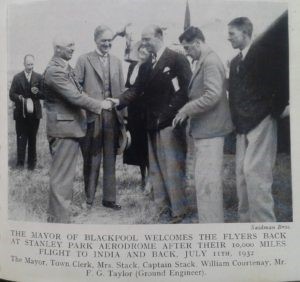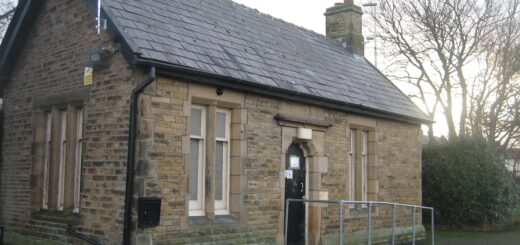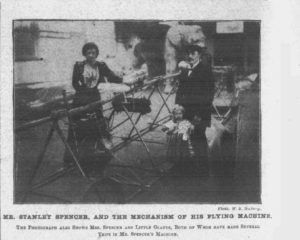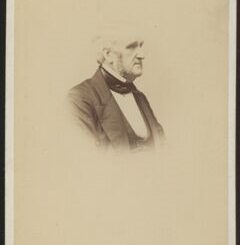The Flight of the Mailplane ‘Blackpool’ June 1932
The Spartan mail plane ‘Blackpool’ which set off from Blackpool Stanley Park airport at 5.35pm on Wednesday 15th June 1932 on its way to Karachi, had a special significance for the town. As a mail plane, it was the first of its kind to be used abroad, and was not out to break records, which was all the rage in aeronautical circles at the time, but to promote British engineering, and the name of the town which sponsored the flight. It was ‘christened’ the town’s name in Blackpool, before flying down to Heston airport to clear customs, and from where it began its journey. It carried messages from Blackpool to all the civic heads of the cities in which the plane would land on its journey.

https://commons.wikimedia.org/wiki/File%3ASpartan_Mailplane_G-ABLI_1932.jpg
The monoplane had a range of 1,000 miles and, with its 110hp Gypsy engines, had a cruising speed of 95mph, (in ‘still air’ ie without head or tail winds). It was estimated that from Blackpool, it should reach the destination of Karachi, after its 5,000 mile journey, in under three days, using 250 gallon of fuel.
It was piloted by Captain Neville Stack (ex RFC and RAF and a flying instructor and test pilot) and his two companions, ground engineer F G Taylor and correspondent William Courtenay (ex RFC/RAF and friend, confidante and agent to Amy Johnson).
In the beginning, Neville Stack, an experienced pilot of long distance flights, had been asked to try out a new 3 seater monoplane, built by the Spartan Aircraft Co and designed for mail, with a view to purchases of the machine by the Director of Civil Aviation. Being a friend of William Courtenay, he had asked him to join him on the flight. William jumped at the chance since he wanted to ‘secure some personal experience of long distance flying,’ but being one of the great adventurers and promoters of early flight, and with good experience of promoting Amy Johnson’s triumphant homecoming tour of Britain, sponsored by the Daily Mail, he wanted to make the most of the opportunity to publicise the flight.
In order to promote flying as a feasible mode of public transport in the face of stiff opposition from the established modes of transport and public scepticism, which denied aeronautics the funding to develop, William Courtenay was always on the lookout for new ideas. He decided that to fly from a provincial aerodrome in the north of England, would show the value of air flight over long distances. It wasn’t enough just to fly from the closest airstrips in Britain to the continental mainland. Its potential and universal usefulness (initially, for Britain, to the limits of the ‘Empire’), needed to be demonstrated.
William Courtenay, the quintessential Engishman was born William Urinowski, son of Russsian, immigrant parents in the Wirral, and was well aware of the North of England and in particular Blackpool of which ‘there is no resort in the country….like Lancashire’s mighty playground,’ and its well-constructed aerodrome at Stanley Park. It was well within his persuasive skills to contact the Aerodrome Committee of Blackpool, and he and Captain Stack were invited to the town to discuss the flight, which would start and finish in a flourish at the town’s aerodrome. William would maximise the town’s publicity for the event, and Blackpool would give every assistance and absorb the costs of both the departure and the arrival events.
William contacted the editor of the Blackpool Gazette. The renowned H R Grimes, did not hesitate to contract him out as the Gazette’s correspondent on the flight, and William would dispatch his exclusive stories, via his typewriter on board, every day.
When the first two dispatches, written in the air, were mailed back to Blackpool and printed in the paper, it was the first time ever that an Air Correspondent on a long distance flight had mailed home dispatches and had them printed.
Once the event had been agreed, it was William Courtenay’s job to organise an air display to coincide with the event of the take-off. Knowing many people in the aviation world, he was able to ask many fliers to attend with their mechanics and friends. 5,000 schoolchildren would be invited, and the publicity would expect to attract the same number of adults. The Mayor, Alderman Newsome, had publicity brochures printed and these would be given to all the heads of state at the landing points of the aircraft en route. Letters of goodwill would be included from the Civic authorities and the townsfolk of ‘the famous resort’, along with, almost inevitably, a stick or two of the famous Blackpool rock. It also carried several small tins shaped like Exide batteries since the Exide conference ‘just happened’ to be in town, and these were distributed en route to their depots.
The date was set for June 15th (1932) and the aeroplane was duly ‘christened’ ‘Blackpool’ with a dose of champagne, by the Mayor. The ’plane also carried a small flag of the town’s civic coat of arms. It was a glorious sunny day and the schoolchildren and adults enjoyed a ‘happy afternoon’ on what was a(n) historic day.

Two of William Courtenay’s – and Amy Johnston’s friends – were Pauline Gower and Dorothy Spicer. They had their own airplanes and eventually their own company, carrying passengers. They brought their machines to Blackpool and Miss Gower took the 50 lucky readers, given free flights by the Gazette, up in the air in her plane.
Neville Stack and William Courtenay were guests of Jack Strain manager of the Cleveleys Hydro Hotel (a building long since demolished and now available to view only in old photographs). It was where all the aviators (and aviatrices) stayed when they visited Blackpool.
The flight took off at 5.35pm and reached Heston aerodrome in London to clear customs, but a little engine trouble which took some time to fix, delayed their arrival in Marseille until 10.25am on Thursday 17th. Here, an oil leak delayed them again for a few hours. But William had been able to send his first despatch back to the Gazette at Blackpool, typed out at 4.30am as they had crossed the channel. The flight progressed, enduring magneto trouble, dust storms, excessive heat, officious customs officials, and darkness where navigation relying on ground features was impossible. They stopped at Rome, Brindisi, Athens, and Aleppo. When Baghdad appeared below, the lights on the ground through the darkness of the night sky were likened to Blackpool Illuminations. Here, once landed, the familiar Lancashire voices of No. 70 Bomber Squadron greeted them. The Lancashire Squadron seeing the name of their famous resort on the aeroplane, made them guests in the Mess, and were treated, in return, to a few sticks of Blackpool rock on departure. Both William Courtenay and Neville Stack had been in both the military and the air force during the War. Basrah was the next destination, familiar town names to us all these days – the seeds of today’s troubles and conflicts had already been sown long before the flight of the Blackpool arrived in the Middle East. Bushire in Iran, (formerly Persia) was the next stop, then Jask, Gwadar and finally Karachi after over 5,000 miles and 5 days 23hrs 50mins and 51hrs 35mins flying time. The Blackpool had brought greetings and had spread the name of its home town throughout the route.

They remained for ten days at Karachi and during that time, another, personal cargo was carried by Captain Stack. The watchman (chowkidar) at the airport, a man named Sirdar Khan, had never received his war medals from the War Office despite countless requests to pilots who were going back that way to England. Neville Stack, one of the airmen asked, had not forgotten, and had taken the time to find them out and brought them back on the Blackpool, where they were pinned to the tunic of the man who had gone to fight and offer his life in a distant land with different customs, far away in the muddy, horrific battlefields of Europe.
The return journey also had its events. At Bushire, the carburettors choked with the dust and, with predicted dust storms, demanded a frustrating wait. In between Baghdad and Aleppo the cockpit cowling blew off leaving the pilot exposed to the elements, such were the vagaries of early flight. Over the Adriatic, further engine trouble required a forced landing in a remote part of Greece, and among people who had never seen an aeroplane before, except perhaps in the distant sky. After Marseille they stopped again at Lyon due to engine trouble once more, and so by-passed Paris which was the scheduled stop. This resulted in them missing the wire from Blackpool to inform them that the arrival ceremony had been put back a day to the Monday. Unaware of this they had dropped off an ETA at Lympne and then travelled on to Blackpool only to find an empty aerodrome, so they turned back to Barton airport and stayed the night there, giving them the opportunity to pass through customs and be ready for the following day.
The next morning, returning to Blackpool, they flew the length of the golden sands before landing at the beflagged aerodrome of Stanley Park. Small gifts had been brought back from India, and a (ceramic?) plate for the Town Hall. It is curious to know where the many gifts bestowed upon the town over the years by various parties or individuals, are still in existence. Perhaps they have been discarded, as memories are short and relevances limited in time. The flags with the civic arms, a little more battered than when they had set off, became adornments for the mayor’s parlour. Many letters of exchange were also brought back.

William Courtenay was born William Urinowsky in the Wirral in 1896. He had a twin brother, Paul, who appears to have died young, a younger brother Alexander killed at his RAF base in France in 1918 and an elder sister, a teacher and whose fiancé Noel Finucane (KLR), a survivor of the Lusitania, was killed in Belgium (Ypres) 4/1/1917.
In changing his name to Courtenay, he breaks from the Russian heritage of his parents, probably because Courtenay sounded more English. In his autobiography published in 1937, he makes no reference to his early life, but names his only child, a son Paul (from his first wife, who died in childbirth). Nor does he make any reference to the deaths of the two sisters in Blackpool during Alan Cobham’s flying air circus in 1935 at which he was present. Perhaps this is because he didn’t want to draw attention to the dangers of flying when all his energies were being put into promoting the value of flight as the future of long distance transport at the time of writing.
Refs.
https://en.wikipedia.org/wiki/T._Neville_Stack
Pictures are taken, except the Wiki pic at the beginning, from William Courtenay’s autobiography ‘Airman Friday’ written and published in 1937.
August 5th, 2021




